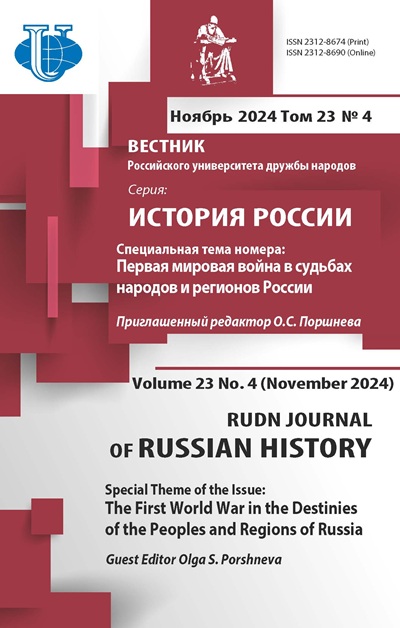Baptism of Adepts of Judaism in the Turkestan Krai in the Second Half of the 19th - Early 20th Century: Scope and Motivation
- Authors: Litvinenko P.V.1
-
Affiliations:
- OJSC VNIIR-Progress
- Issue: Vol 21, No 3 (2022): The Petrine Reforms and the Peoples of Russia: On the 350th Anniversary of the Birth of Peter I
- Pages: 404-416
- Section: ARTICLES
- URL: https://journals.rudn.ru/russian-history/article/view/31795
- DOI: https://doi.org/10.22363/2312-8674-2022-21-3-404-416
Cite item
Full text / tables, figures
Abstract
The author considers the study of the issue of the Jewish population conversion to Christianity in the Turkestan Krai. The article reveals the religious situation in tsarist Russia related to the problems of Jews’ conversion, provides reliable facts of the conversion with regard to the most important Islamic outskirts of the empire - Turkestan, where the overwhelming majority of the population belonged to Islam - over 95%. The author examines the reasons for the conversion of regional Jews to Christianity and the real consequences of this process. The peculiarity of Turkestan made a significant impact on the spiritual life of Jews, on the nature and motives for the adoption of Christianity. In the Central Asian region, Jews were not a homogeneous group; they often had different features of culture and traditions. There were several Jewish communities there: the so-called “European” Jews (who arrived from Russia) led by their own chief rabbi; besides, in Central Asia there lived “native” Jews who got the status of Russian citizens and had their own rabbi. In this regard, it seems interesting to trace the conditions of the conversion of these different groups of Jews to Christianity, their motives and the attitude of official authorities towards them. It is important to note that the Jews of the Turkestan Krai converted not only to Orthodoxy, but also Catholicism, Lutheranism, Armenian-Gregorianism, and other faiths. However, the tsarist authorities believed that the conversion of Jews to non-Orthodox confessions was not enough to free them from the imposed legislative restrictions. In general, the example of the situation in Turkestan allows us to see that the features of the adoption of Christianity and the change in the legal status of Jews often depended on the region in which they were baptized. In addition, it was the factor of belonging to a certain Jewish community that played an important role.
Keywords
About the authors
Pavel V. Litvinenko
OJSC VNIIR-Progress
Author for correspondence.
Email: masterlitvinenko@yandex.ru
General Director 4, I.Ya. Yakovleva Ave., Cheboksary, 428024, Russia
References
- Ausubel, N. The book of Jewish Knowledge. New York: Crown, 1964.
- Baron Salo, W. The Russians Jews under Tsars and Soviets. London: Macmillan, 1976.
- Bartol’d, V.V. Istoriya kulʹturnoy zhizni Turkestana. L.eningrad: akademiya Nauk SSSR Publ., 1927 (in Russian).
- Baturkin, A. “Religious Policy of the Russian Empire in the Second Half of the 20th Century.” Vlast' Journal, no. 2 (2009): 77-79 (in Russian).
- Dudakov, S.Yu. Petr Shafirov. Iyerusalim: [S.n.], 1989 (in Russian).
- Dvorkin, I.S., ed. Evrei v Sredney Azii: proshloe i nastoyashchee. Ekspeditsii, issledovaniya, publikatsii. Sbornik nauchnykh trudov. St. Petersburg: peterburgskii Evreiskii Universitet Publ., 1995 (in Russian).
- Frumkin, J., Aronson, G., and Goldenweiser, A. Russian Jewry (1860-1917). New York; London: Union of Russian Jews, 1964.
- Gerasimova, V.A. “ ‘Friends’ and ‘Strangers’: the Baptism of Jews in Russia in the 18th Century.” Bulletin of the Russian State University for the Humanities. Series: Culturology. Art criticism. Museology, no. 15 (2010): 139-146 (in Russian).
- Gitlin, S.I. “European Jews in Russian Turkestan at the turn of the 19-20th centuries.” RUDN Journal of Russian History 17, no. 2 (2018): 296-319. doi: 10.22363/2312-8674-2018-17-2-296-319 (in Russian).
- Goldenweiser, G. “Legal status of Jews in Russia.” In Russian Jewry (1860-1917), 320-335. New York; London: Yoseloff, 1964.
- Israel, G. The Jews in Russia. New York: St. Martin`s Press, 1975.
- Kaganovich, A. Druz’ya ponevole. Rossiya i bukharskie yevrei, 1800-1917 gg. Moscow: NLO Publ., 2016 (in Russian).
- Kahan, A. Essays in Jewish Social and Economic History. Chicago; London: University of Chicago Press, 1986.
- Litvinov, P.P. Neislamskie religii Sredney Azii (vtoraya polovina XIX - nachalo XX vv.). Yelets: Yeletskiy gosudarstvennyy pedagogicheskiy institut Publ., 1996 (in Russian).
- Mikayelyan, V. Kak i pochemu rossiiskie evrei prinimali khristianstvo po armyanskomu obryadu (1910-1915). Yerevan: Nairi Publ., 1999 (in Russian).
- Minkina, O. “Kozha and Deputies: ‘Jewish Politics’ of the End of the 18th Century - the Beginning of the 20th Century in the Folklore ‘Pale of Settlement’.” Zelenin readings. Anthropological Forum, no. 11 (2009): 315-327 (in Russian).
- Norkina, Ye. “Yevrey armyano-grigorianskogo ispovedaniya: k voprosu o motivakh kreshcheniya evreyev v Rossiyskoy imperii v nachale XX v.” In XXII Mezhdunarodnaya yezhegodnaya konferentsiya po iudaike. Golitsyno, 1-3 fevralya 2015 goda, 171-182. Moscow: Probel-2000 Publ., 2015 (in Russian).
- Porath, J.D. Jews in Russia. The Last Four Centuries. New York: United Synagogue Commission on Jewish Education, 1974.
- Safonov, A.A. Gosudarstvo i konfessii v pozdneimperskoy Rossii: pravovyye aspekty vzaimootnosheniy: monografiya. Moscow: Prospekt Publ., 2021 (in Russian).
- Teryukova, Ye.A. “On Freedom of Conscience and Freedom of Religion in Russia (1907-1917).” Vestnik of Saint Petersburg University, no. 3 (2013): 56-60 (in Russian).
- Teryukova, Ye.A. “Russian Legislation of the Early 20th Century on Religious Transitions.” Religious Studies, no. 3 (2013): 163-177 (in Russian).
- Vert, P. Pravoslavie, inoslavie, inoverie: ocherki po istorii religioznogo raznoobraziya Rossiyskoy imperii. Moscow: NLO Publ., 2012 (in Russian).
- Vibe, Ye.N. Veroispovednaya politika samoderzhaviya v Zapadnom kraye (1830-1855). St. Petersburg: Sankt-Peterburgskiy institut istorii RAN Publ., 2009 (in Russian).
- Zaslonovskiy, S. “Kak sovershaetsia tainstvo Kreshcheniia v Turkestane i kak ono dolzhno sovershat'sia.” Turkestanskie eparkhial'nye vedomosti. April 15, 1908, 235-239 (in Russian).
















